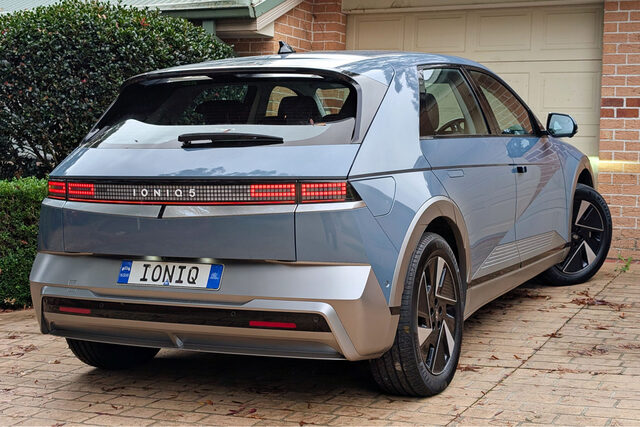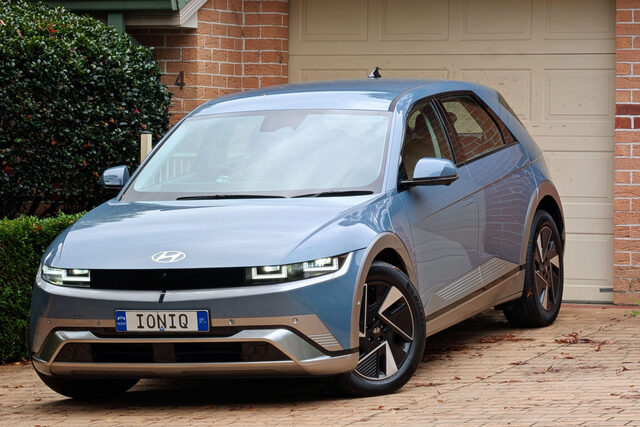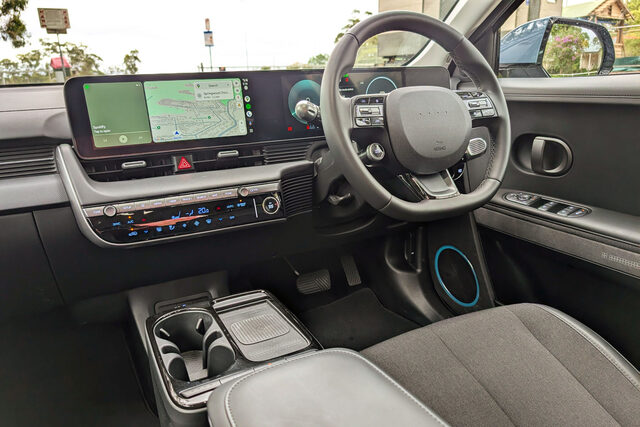The Ioniq 5 is not Hyundai’s first fully electric vehicle, not by a long shot, but it was their first EV based on a dedicated battery-electric platform.
The look of the car is inspired by Hyundai’s original Pony car, a small hatch from the 1970s that was South Korea’s first mass-produced exported vehicle.
The dedicated E-GMP electric vehicle platform offers advantages over dual purpose vehicles such as the Kona that are marketed with both electric or internal combustion powertrains.
In the case of the Ioniq 5 it means a fully flat floor and long three-metre wheelbase that delivers plenty of legroom and a largish boot. Generous rear legroom was achieved by making the front seats about 30 per cent thinner than typical seats.
Ioniq 5 now shares a platform with the Ioniq 6, Ioniq 9, Kia EV6, Kia EV9 and Genesis GV60. Prices for the Ioniq 5 start from $69,800 before on-road costs. Our test vehicle was the top of the range rear-wheel drive Epiq with a single electric motor, extended range battery and 20-inch wheels, and a range of 530km – priced from $84,300.
Ioniq 5 comes in three grades, Ioniq 5, Dynamiq and Epiq, with one or two electric motors and rear- or all-wheel drive along with a standard or extended range battery.
A high performance N model is now also offered priced from a breathtaking $110,000.
STYLING
Ioniq 5 received a facelift in July last year, with new look bumpers, a rear spoiler and redesigned wheels etc. A windscreen wiper was also added to the rear window at this time. Inside, the centre console was redesigned to provide easier access to air and seat heating controls. The steering wheel, instrument cluster bezel, multimedia screen, and seat pattern were also updated.
Many of the interior parts are made from recycled materials, including plastic bottles.
The size of the wheels plays a significant role in the ultimate range of the car which currently varies from 440km to a high of 570km.
The N Line sports pack adds $3150 to the price. Premium paint adds $1000, the N Line Pack $2500 and the Digital Mirror Pack $3000.
You might pay for it, but the Ioniq 5 is certainly well equipped.
Standard kit includes dual-zone climate air, combination wool and leather upholstery, leather-wrapped steering wheel, acoustic laminated windscreen and side door glass, proximity entry with push-button start, power adjust driver seat and two-way manual recline rear seats (fore/aft adjustment, 60:40 split/fold), LED interior lighting and adjustable ambient lighting.
There’s also a 12.3-inch digital instrument cluster, LED headlights, automatic high-beam, traffic sign recognition, auto lights and wipers, auto dimming rear view mirror, heated, power-fold mirrors, remote smart parking and tyre pressure monitoring.
Epiq adds 20-inch wheels with Michelin Pilot Sport EV tyres, eco-processed leather, smart LED projection headlights, rear privacy glass, rear door sunshades, power-operated tailgate, glass roof with power sunshade, front and rear heated seats, cooling for the front seats, heated steering wheel and two driver-seat memories.
Digital side mirrors are an option, but make sure you try them before you buy them.
Standard warranty is five years with unlimited kilometres. There’s an eight-year, 160,000km battery replacement warranty.
INFOTAINMENT
Infotainment consists of a 12.3-inch touchscreen, Bluetooth multi-connection, Voice control system, AM/FM and DAB+ digital radio, wireless Apple CarPlay and Android Auto, Bluelink connected satellite navigation.
This model also scores Bose premium audio with eight speakers. There’s wireless phone charging and four USB-C ports, Vehicle-to-load (V2L) outlet inside the car and the system now supports over-the-air updates.
Bluelink connected car services, complimentary for five years, includes automatic emergency SOS.
It also allows users to set charge time, monitor distance to empty and can restart charging if necessary.
The app allows the owner to find EV charging stations and send the address to the car’s sat navigation.
A tool shows the driveable radius with 80 and 100 per cent charge levels.
SAFETY
Ioniq 5 scores a full five stars for safety, with seven airbags including a centre bag in the front, 360-degree camera and autonomous emergency braking (AEB).
AEB supports Car-to-Car, Vulnerable Road User, Junction Assist and Backover capabilities.
There’s also head-up display, a blind spot camera with blind spot warnings, as well as a lane support system with lane keep assist (LKA), lane departure warning (LDW) and emergency lane keeping (ELK), and an advanced speed assistance system (SAS) are standard on all variants.
ENGINES/TRANSMISSIONS
Our test vehicle is powered by a single electric motor that delivers 168kW of power and 350Nm of torque, with drive to the rear wheels through a single-speed reduction gear transmission.
DRIVING
The Ioniq 5 is by any measure an impressive car. It’s not often that my better half and I agree on a car, but we both warmed to the Ioniq.
More so because it performs like the kind of cars we’re used to, even though it’s an electric vehicle.
The Ioniq 5 Epiq (love that name) is quick and comfortable with plenty of legroom front and back plus a good-sized boot – all the things one looks for in a car.
As well as the boot there’s storage under the bonnet in the form of a frunk; 57 litres in the RWD and 25 litres in the AWD which is handy for storing cables.
It’s got a decent amount of range for an electric vehicle too, with up to 570km if you tick the right boxes. In fact, it’s the first EV we’ve driven that indicated an initial range of more than 600km fully charged – can you believe it?
But why you’d option the larger, 20-inch wheels at the expense of driving range doesn’t make sense. Give us the 19s any day!
Anyone with an EV will tell you, it’s all about the range (and where and when you can recharge the car).
Even though our test vehicle showed 620km when we picked it up, we’re starting to believe this must be like ‘shop mode’ for TVs (makes them brighter and more vibrant).
That’s because the real range turned out to be 530km – the claimed range anyway. You sacrifice 40km stepping up from 19- to 20-inch wheels in the rear-drive Epiq.
It might not sound much, but it can make a difference when you get down to it. Further, despite the advertising, we’ve never found an EV or charge station that can deliver on the wildly optimistic promises that carmakers make of being able to recharge in less than 20 minutes.
It just doesn’t pan out; despite the fact we have a bank of 300kW Tesla Superchargers down the road.
And, when did a full charge morph into 80 per cent; keep in mind that a small portion of the battery is reserved for the system to continue functioning.
You can charge the battery to 100 per cent using a slower AC charger, but the industry has decided that 80 per cent is the mark when it comes to fast DC charging, otherwise it can shorten battery life. The charge is stored in an 84 kWh liquid-cooled lithium-ion battery pack in the extended range, 80 kWh of which is useable.
Ioniq 5 has battery preconditioning to facilitate faster charging. This will take 35 hours with a so-called ‘granny’ charger (10A household power point), 11.6 hours with a home charge station, or as little as 18 minutes from 10-80 per cent with a 250kW plus DC fast charger.
For a car that weighs over 2 tonnes, the Ioniq gets moving. The dash from 0-100km/h takes 7.3 seconds and it has a top speed of 185km/h.
There are five selectable drive modes: Eco, Normal, Sport, My Drive, Snow which have accompanying instrument themes. Adding some drama to the drive experience is a virtual sound system with a choice of artificial sounds.
They’re electronica rather than engine emulations, in case you’re interested. Not many people are.
Brake mode offers another two settings: Normal and Sport. Regenerative braking can be adjusted via the steering wheel mounted paddles, right down to one-pedal braking which brings the car to a stop when you lift off the accelerator.
There’s also ‘Smart’ regenerative braking which is traffic and navigation based. Or you can choose to ignore these settings and simply drive the car.
The ride is generally good but like most EVs it can become bouncy at times, as the springs load and unload. The large external mirrors can obscure vision, particularly the driver side mirror when you’re trying to look through a corner. If you’re parked on a slope, releasing the handbrake and moving off in reverse requires a dab touch on the accelerator, but just a touch.
Be ready to catch it with the brakes because the car is liable to lurch backwards. Fingers over or under? Facing the wrong direction, the pop-out handles are awkward to use.
The twist grip gear selector is present in many Hyundais and takes some mastering.
Although putting the car into park requires just the push of a button (which also engages the handbrake), we continually forgot to actually turn off the car. Automatic reverse and parallel parking are available if you feel game.
Speed sign recognition is annoying because it sounds a warning when you’re over the limit (like it is supposed to). The trouble is that it is often wrong, displaying a speed limit that does not relate to the current surroundings.
With claimed Energy consumption of 16.99 kWh/100km, we bettered that figure at 15.5 kWh after 375km of mixed driving. The long-term average showed as 15.8 kWh after close to 2000km. A quick trip down the motorway returned 13.2 kWh.
SUMMING UP
The Ioniq 5 is an impressive car and one of the few EVs that we would consider buying. It doesn’t chew through the battery too quickly and with 530km of range, more if you’re sensible and opt for the smaller 19-inch wheels, it compares favourably with a conventional car.
But at just over $90,000 by the time you put it on the road, it’s just too damned expensive, at least for the average consumer. Even the base model is $75,000 driveaway.
This from Hyundai?
We’re not rich, and we’re not poor, but we baulk at the prospect of spending this much on a car, especially one that could quickly become outdated as the technology continues to evolve. Then there’s the charging infrastructure to consider, which quite frankly isn’t there yet. Remember how much we used to pay for flat screen TVs and what they cost now?
RATINGS:
Looks: 7.5
Performance: 8
Safety: 8
Thirst: 7
Practicality: 7
Comfort: 7
Tech: 8
Value: 7
Overall: 7.4











